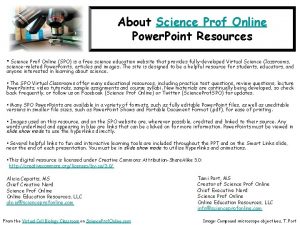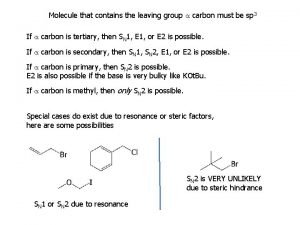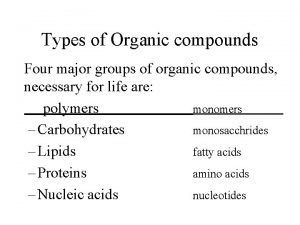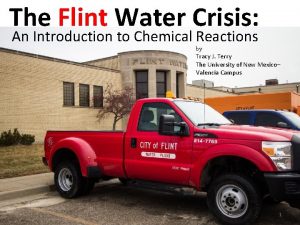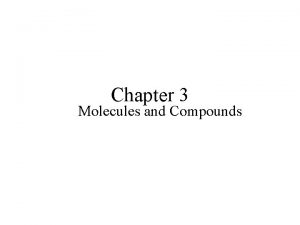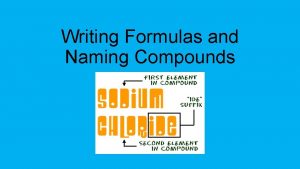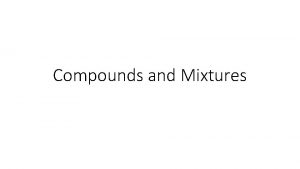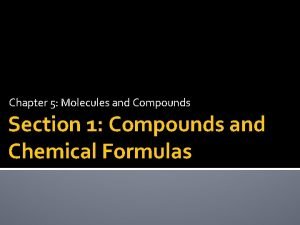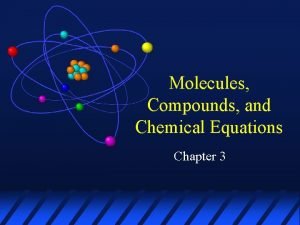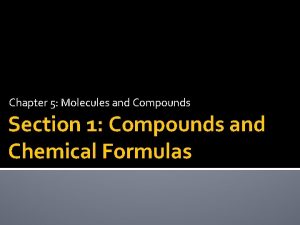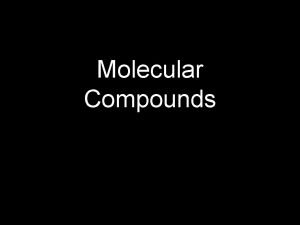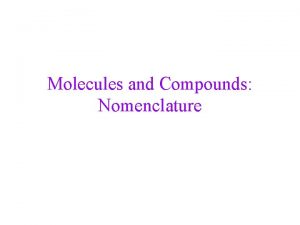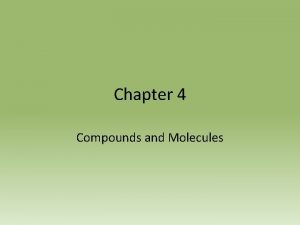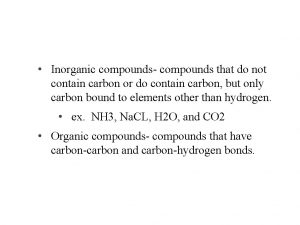What are molecules and compounds Molecules are groups












- Slides: 12

What are molecules and compounds? • Molecules are groups of two or more atoms chemically bonded together (ex. H 2 O and H 2 are both molecules) • Compounds are molecules that consist of two or more different elements (ex. H 2 O is a compound but H 2 is not) • The numbers to the right of each atom tell you how many of that atom are in the molecule. If there is not a number, then it’s just one (1) there is only one oxygen atom H 2 O Tells you there are two hydrogen atoms in this molecule H 2 there are two hydrogen atoms in this molecule

Practice Find the following for a given molecule: CO 2 Which atoms make it up? How many of each? NH 3 Li. Al. H 4 CO 2 H 2

What are molecules and compounds? • Molecules and compounds are formed and changed into new molecules via chemical reactions • Chemical reactions occur when chemical bonds are broken and/or new bonds are formed, thus forming new molecules • Chemical reactions absorb (endergonic) or give off (exergonic) energy Reactants • Elements and compounds you start with Products • Elements and compounds you end with

What are molecules and compounds? • A chemical bond is a force of attraction between two atoms and depends on the number of valence electrons • Atoms prefer full orbitals (2, 8, 8), so the number of valence electrons determines the type and number of bonds an atom will form with others ü Atoms with 1, 2, or 3 valence electrons tend to want to give these away Become Ions! ü Atoms with 6 or 7 valence electrons tend to try to gain the missing one or two they need ü Helium and atoms with 8 valence electrons do not react (noble gasses) ü Atoms with four or five valence electrons share ü Hydrogen will both share or give away its electron (become an H+ ion) Hydrogen (H), 1 Helium (He), 2 O Ne C H He Sodium (Na), 11 Oxygen (O), 8 Neon (Ne), 10 Carbon (C), 6

What are molecules and compounds? • Types of chemical bonds: ü Ionic bonds – attraction between two ions forming a salt ü Covalent bonds – nuclei of two atoms are both strongly attracted to the electrons and share them

Bonding examples: http: //www. visionlearning. com/library/module_viewer. php? mid=55 http: //www. mhhe. com/physsci/chemistry/animations/chang_7 e_esp/bom 1 s 2_11. swf

What are molecules and compounds? • Types of chemical bonds: ü Ionic bonds – attraction between two ions forming a salt ü Covalent bonds – nuclei of two atoms are both strongly attracted to the electrons and share them Van der Waals Forces – slight attraction between oppositely charged regions of nearby molecules formed as the electrons quickly move around the nuclei (greater surface area creates greater attraction; ex: gecko feet) Hydrogen Bonds (Polarity)

What is Polarity? • Polar compounds are covalently bonded molecules that are neutral overall, but have positive and negative regions due to uneven sharing of electrons ü H’s almost always share electrons unequally taking on a slight + charge • Hydrogen bonds (H-bonds) are weak attraction between slightly positive hydrogen atoms in a polar compound and negative ions or slightly negative regions of another polar compound • Hydrogen bonds play an important role in many organic molecules (ex: the strands of a DNA molecule are held together by hydrogen bonds)

What is Polarity? • Hydrophilic Compounds Polar or charged compounds that are attracted to water (form H-bonds with water) • Hydrophobic Compounds Non-Polar compounds that avoid interaction with water (prefer to interact with other neutral compounds) • Molecules that are both hydrophobic and hydrophilic produce micelles in water ü these types of molecules make up cell membranes

What is Polarity? Water is cohesive – in cohesion molecules of water are attracted to one another (water tension)

What is Polarity? Water is adhesive – in adhesion molecules of water are attracted to other substances • Mixtures are composed of two or more elements or compounds mixed together but not chemically combined ü Solutions are mixtures in which ionic compounds dissociate in water and are evenly spread out (ex: salt dissolving in water forms Na+ and CL- ions) Solute – the ionic substance that dissolves (dissociates) Solvent – the substance in which the solute dissolves (most often water) Water adhesion to glass is stronger than water cohesion Salt dissolving in water = a solution

What is Polarity? Water is adhesive – in adhesion molecules of water are attracted to other substances • Mixtures are composed of two or more elements or compounds mixed together but not chemically combined ü Solutions are mixtures in which ionic compounds dissociate in water and are evenly spread out (ex: salt dissolving in water forms Na+ and CL- ions) ü Suspensions are mixtures in which tiny clumps of compounds mix with water but DO NOT dissolve/dissociate. Over time, the particles of a suspension may settle to the top or bottom or can be separated out using a filter Ex: fine dirt/sand in water, blood cells in blood ü Mixtures can be separated via Dehydration (water evaporates out) Chromatography (physically separate the particles using some sort of filter – charged materials help separate ions by attracting them) You can separate multiple different particles from a mixture based on size or charge using different types of filters and solutes
 Mikael ferm
Mikael ferm Compound substance
Compound substance Venn diagram ionic and covalent compounds
Venn diagram ionic and covalent compounds Organic molecules vs inorganic molecules
Organic molecules vs inorganic molecules How are ethnic groups and religious groups related
How are ethnic groups and religious groups related All compounds are molecules
All compounds are molecules Molecules vs compounds
Molecules vs compounds Which molecules contain good leaving groups?
Which molecules contain good leaving groups? Four types of organic compound
Four types of organic compound Relationship between atoms and molecules
Relationship between atoms and molecules Dissolved oxygen and chlorine molecules act as
Dissolved oxygen and chlorine molecules act as Solid liquid gas particle diagram
Solid liquid gas particle diagram Planar chirality
Planar chirality






